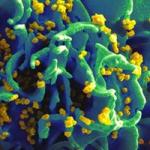
Jeffery K. Taubenberger, M.D., Ph.D.
Senior Investigator
Viral Pathogenesis & Evolution Section
NIAID/DIR
Research Topics
The Viral Pathogenesis and Evolution Section seeks to address fundamental questions of influenza virus pathogenesis in different animal hosts, including the mapping of viral virulence factors and mutations associated with host adaptation, as well as characterizing the host response to infection. The role of secondary bacterial infections in influenza infection is being examined. Experiments are also being performed to evaluate novel therapeutics for the treatment of severe influenza and to evaluate the significance of heterosubtypic and heterotypic immunity to influenza viral antigens.
The section studies viral evolution and fitness through the development of improved viral surveillance and genomics. These efforts employ both in vitro assays and experimental animal model systems. These studies seek to understand the dynamics of viral evolution in different hosts, including birds, mammals, and the evolutionary dynamics of human pandemic and seasonal influenza viruses.
Since completing the sequencing of the 1918 pandemic viral genome, the section has maintained an interest in archaevirology and is seeking to characterize pre- and post-1918 influenza virus genomes from archival samples.
The section also performs translational research involving clinical trials addressing pandemic and seasonal influenza viral infections in patients with and without immunocompromise. These investigations include characterization of the development of antiviral resistance mutations, intra-host viral evolution, and characterization of the host immune response. Postmortem examinations of lung tissue from fatal cases of pandemic and seasonal influenza are employed to understand the development of severe influenza viral disease in humans. The section has recently begun a human volunteer influenza virus challenge study. Finally, the section continues to develop novel molecular genetic assays for influenza viruses for diagnosis, surveillance, and mutation screening.
Together, such investigations will help shed light on the emergence, evolution, and severity of influenza pandemics as well as seasonal influenza.
Biography
Dr. Taubenberger received a B.S. in biology from George Mason University in 1982. He earned his medical degree in 1986 and his Ph.D. in 1987, both from the Medical College of Virginia. He completed a residency in pathology at the National Cancer Institute and holds dual board certifications in anatomic pathology and in molecular genetic pathology from the American Board of Pathology and the American Board of Medical Genetics. Prior to coming to NIAID in 2006, he served as chair of the Department of Molecular Pathology at the Armed Forces Institute of Pathology in Washington, DC, a position he held since 1994. Dr. Taubenberger’s research interests include influenza virus biology, evolution, pathophysiology, and surveillance. He also has clinical interests in the development and implementation of molecular diagnostic assays for neoplasia and infectious diseases.
Memberships
- American Society for Microbiology
- American Academy of Microbiology
- Association of American Physicians
Editorial Boards
- Virology
Selected Publications
- Park J, Fong Legaspi SL, Schwartzman LM, Gygli SM, Sheng ZM, Freeman AD, Matthews LM, Xiao Y, Ramuta MD, Batchenkova NA, Qi L, Rosas LA, Williams SL, Scherler K, Gouzoulis M, Bellayr I, Morens DM, Walters KA, Memoli MJ, Kash JC, Taubenberger JK. An inactivated multivalent influenza A virus vaccine is broadly protective in mice and ferrets. Sci Transl Med. 2022;14(653):eabo2167.
- D'Agnillo F, Walters KA, Xiao Y, Sheng ZM, Scherler K, Park J, Gygli S, Rosas LA, Sadtler K, Kalish H, Blatti CA 3rd, Zhu R, Gatzke L, Bushell C, Memoli MJ, O'Day SJ, Fischer TD, Hammond TC, Lee RC, Cash JC, Powers ME, O'Keefe GE, Butnor KJ, Rapkiewicz AV, Travis WD, Layne SP, Kash JC, Taubenberger JK. Lung epithelial and endothelial damage, loss of tissue repair, inhibition of fibrinolysis, and cellular senescence in fatal COVID-19. Sci Transl Med. 2021;13(620):eabj7790.
- Park JK, Xiao Y, Ramuta MD, Rosas LA, Fong S, Matthews AM, Freeman AD, Gouzoulis MA, Batchenkova NA, Yang X, Scherler K, Qi L, Reed S, Athota R, Czajkowski L, Han A, Morens DM, Walters KA, Memoli MJ, Kash JC, Taubenberger JK. Pre-existing immunity to influenza virus hemagglutinin stalk might drive selection for antibody-escape mutant viruses in a human challenge model. Nat Med. 2020;26(8):1240-1246.
- Walters KA, Zhu R, Welge M, Scherler K, Park JK, Rahil Z, Wang H, Auvil L, Bushell C, Lee MY, Baxter D, Bristol T, Rosas LA, Cervantes-Medina A, Czajkowski L, Han A, Memoli MJ, Taubenberger JK, Kash JC. Differential Effects of Influenza Virus NA, HA Head, and HA Stalk Antibodies on Peripheral Blood Leukocyte Gene Expression during Human Infection. mBio. 2019;10(3).
- Walters KA, D'Agnillo F, Sheng ZM, Kindrachuk J, Schwartzman LM, Kuestner RE, Chertow DS, Golding BT, Taubenberger JK, Kash JC. 1918 pandemic influenza virus and Streptococcus pneumoniae co-infection results in activation of coagulation and widespread pulmonary thrombosis in mice and humans. J Pathol. 2016;238(1):85-97.
Related Scientific Focus Areas





Microbiology and Infectious Diseases
View additional Principal Investigators in Microbiology and Infectious Diseases
This page was last updated on Tuesday, August 16, 2022